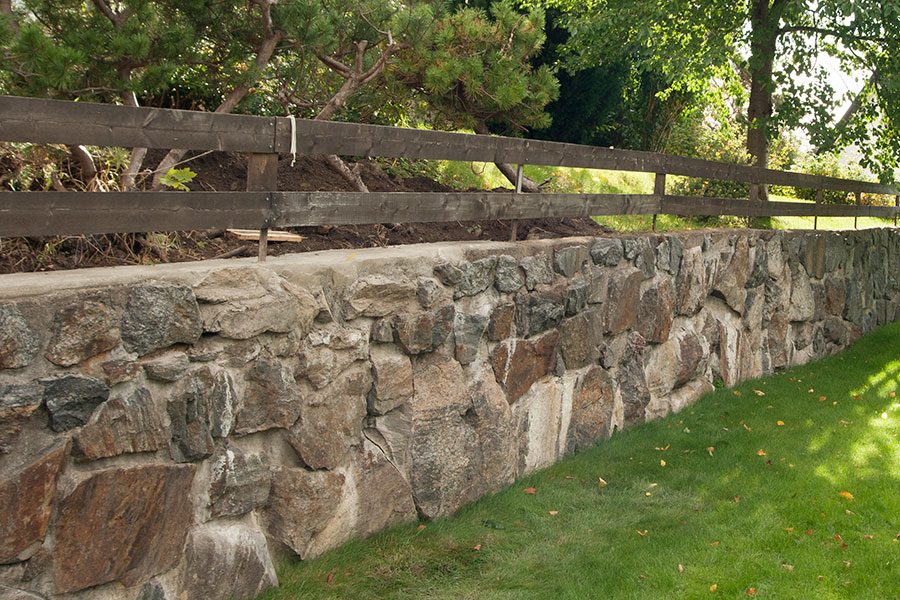There are many different types of walls, from internal to external, from load bearing to non-load-bearing – but what they all have in common is a need for strength and stability. Obviously, no one wants their wall to fall down, or to need replacing far too often. No, walls of any kind need to be strongly constructed of sturdy material, and to be stable, strong, reliable and durable.
So, what’s the best way to ensure your wall can do all this and more? It all comes down to the material the wall is constructed from, as this almost entirely determines the strength and stability of the wall. There are many different approaches to walls – but which one is right for your build? It’s important to choose the best material for wall construction, so let’s take a look at exactly what that might be for all different types of walls.
For a retaining wall
When dealing with a sloping site, retaining walls are an essential part of landscape design. A retaining wall is designed to hold back a lot of soil, and it can’t afford to fail. These highly functional walls provide structural support to turn steeply sloping areas into much more usable space, as well as providing flood and erosion control. They do plenty of heavy work in the garden or landscape design, and need to be strong, durable and stable enough to provide the necessary structural support.
Retaining walls have the potential to be built from many different materials, including timber, stone, concrete, concrete blocks, bricks and gabion. Let’s take a quick look at each of these choices.
Timber
Timber retaining walls can look very attractive, but come with certain limitations and problems. Timber is not as strong as other materials, such as stone and concrete, can be vulnerable to termites, and will eventually rot away. Timber needs to be treated for outdoor retaining wall use, and requires more maintenance than other types of materials. It’s unlikely to last as long as stone or concrete.
Stone
Natural stone retaining walls blend seamlessly with the surrounding landscape, and are a classy material for walls. A stone retaining wall will last for a long time, as stone is strong, sturdy, durable and reliable. The downside? It comes at a cost, with stone being one of the most expensive wall-building materials around.
Poured concrete
For strength, you can’t go past a poured concrete wall. Concrete is incredibly strong and stable, and a solid concrete wall is even stronger than concrete blocks, as solid concrete is denser. It may look a little more industrial however, and solid concrete can be vulnerable to chemical damage and may be susceptible to cracking without some kind of structural support (like steel rods).
Bricks
Bricks are a durable and low maintenance product, but can’t match stone and concrete in terms of strength and stability. As well, they are smaller than concrete blocks, so it will take longer to construct a wall, and they don’t come with an interlocking system to knit the wall tightly together like concrete blocks do. You are limited in colour and style choices when you choose bricks as well.
Concrete blocks
Concrete block systems interlock to create a retaining wall, thereby providing extreme support, structure and strength. The wall is built on a base of compacted gravel, and when correctly built, will remain strong and solid even under pressure. Concrete blocks create an extremely sturdy and long-lasting retaining wall that can often last for over a century. They come in a wide range of colours, styles and sizes, and are a very cost-effective choice as well.
The best choice for retaining walls
When you carefully consider all the options, concrete blocks stand out as the best choice for retaining walls. They offer the best of all worlds – strength, durability and stability, but without having to sacrifice aesthetics, style and choice. And when you factor in their very affordable cost, it’s a no-brainer. Have a look at a high-quality range of concrete blocks for retaining walls here:
For a load-bearing wall
A load-bearing wall provides support for other parts of a building, such as beams, pillars, columns, lintels and vaults (among other things). It’s responsible for distributing loads to the ground on which it stands and therefore needs to be stable enough to support the building. Load-bearing walls are more than 30 centimetres wide, and cannot be taken down during renovations. For example, all of a building’s external walls are load-bearing.
When building a load-bearing wall, the material choices are similar to retaining walls. Load-bearing walls can be constructed from stone, poured concrete, concrete blocks, steel or bricks, as these materials make it possible to bear heavy loads without deformation.
Wood
Timber is a natural building material that has long been favoured for its aesthetic properties. Timber homes look classic and cosy, and it’s an environmentally friendly choice, as wood is a renewable resource. However, wood requires regular high levels of maintenance to keep it looking good and performing well, is highly flammable and is very susceptible to pests such as termites and decay.
Stone
Stone is a traditional and rustic building material, and is known for it’s heat retention and durability. Stone is generally fairly resistant to damage, but it can be susceptible to moisture damage and is cold to the touch. Stone offers few colour choice, and may stain over time. Plus, it’s one of the most expensive building materials around due to the difficulty of quarrying and working with the natural stone.
Steel
Steel is a popular choice for many commercial and industrial buildings, although it’s not regularly used for homes. It offers exceptional strength and support, and plenty of design flexibility, but is prone to corrosion and requires regular maintenance and protective measures to prevent deterioration. It’s also much more expensive compared to other building materials.
Brick
Brick is a traditional building material that has been used for centuries to build walls. It’s durable and long-lasting and can withstand a wide variety of weather conditions. It has excellent fire resistance and requires minimal maintenance. However, it has a high initial cost, imposes structural limitations due to its’ weight, offers limited design options and requires a time-consuming construction process.
Poured concrete
Concrete has many advantages, the greatest being that it’s an incredibly strong and sturdy building material that can support heavy loads with ease. It’s also inflammable and soundproof, so it’s a good choice if you live in areas with extreme weather conditions or next to a busy highway or other noisy location.
Concrete block
Concrete blocks bring all the advantages of concrete, along with a more aesthetic and stylish look. Concrete blocks are easy and cost effective to build with, and are often foolproof, as they are designed with interlocking systems to make building quicker, easier and stronger. They come in a wide range of styles, shapes, sizes and finishes, and are very low-maintenance as well. They are highly resistant to wear and tear and are known for their exceptional strength and longevity.
The best choice for load-bearing walls
While it does depend on your personal choice and the unique requirements of your project, a good all-round choice is concrete blocks. They come in a wide variety of options, including hollow and solid, and are highly cost-effective, while providing great bang for your buck in terms of durability, strength and longevity. They are low-maintenance and easy to build with, and come with plenty of upside and few downsides. You can find a great range of concrete blocks for your walls here: https://www.nationalmasonry.com.au/
For a non-load-bearing wall
Non-load-bearing walls, as they sound, are not responsible for supporting the building structure. Instead, they serve other functions such as separating spaces. They are usually
internal walls of a building, and do not put the stability of the building at risk if they are taken down.
You can use many of the materials listed above for non-load bearing walls (with all the same benefits and drawbacks as listed above) as well as other types such as fibre cement, glass, drywall and plaster.
Fibre cement is strong and durable, and is resistant to rot, moisture and fire. It can be painted or finished in a wide variety of ways. Drywall is easy to install and very affordable. Glass is a popular choice too, as it provides a modern look while allowing natural light to pass through. Plaster is a traditional finishing option for walls that provides a smooth surface for paint or wallpaper.
The best choice for non-load-bearing walls
Ultimately, the best material for your non-load bearing wall will depend on your specific needs. You’ll need to consider the location of the wall, as well as its exposure to the elements and the amount of maintenance you’re prepared to perform. A great choice for almost any wall though, is concrete blocks, as these are available in designer colours and finishes that can make any wall look stylish and appealing. They require low to zero maintenance, have high fire protection, excellent thermal and acoustic performance and are extremely strong and durable. And did we mention cost effective? Have a look at a great range of designer concrete blocks for both load-bearing and non-load bearing applications here.





Leave a Reply
You must be logged in to post a comment.